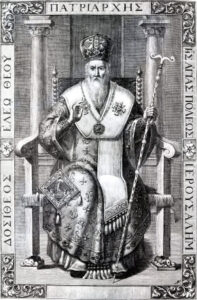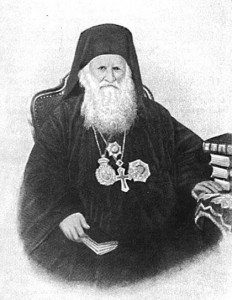From the fall of the Byzantine Empire until the 17th century, it was customary for the Patriarch of Jerusalem to appoint his own successor, usually by making the chosen heir the Metropolitan of Caesarea. In 1666, Patriarch Nektarios of Jerusalem appointed his 25-year-old archdeacon, Dositheos Notaras, as Metropolitan of Caesarea, and two years later, Nektarios resigned, reportedly because he was overwhelmed by the financial crisis in his Patriarchate. Dositheos met with the Ottoman Sultan, who issued a firman (edict) authorizing Dositheos to be the next Patriarch. After this, a remarkable thing happened: In early 1669, Dositheos was elected Patriarch of Jerusalem by the Holy Synod of Constantinople.
This marked the beginning of a new era in the Patriarchate of Jerusalem, in which successive Patriarchs were chosen by the Ecumenical Patriarchate. Already, in the first half of the 17th century, Patriarch Theophanes III of Jerusalem had established a metochion in Constantinople and took up residence there, as did his successors. Now, the election of the Patriarch itself was in the hands of the Ecumenical Patriarchate. For all intents and purposes, Jerusalem’s autocephaly had been subverted, although the Patriarch retained his title and his fourth-place rank in the diptychs. Patriarch Dositheos went on to reign for 38 years, becoming perhaps the most significant Patriarch of Jerusalem in the past millennium. He is most famous for convening the 1672 Council of Jerusalem, which condemned Calvinism and issued an authoritative doctrinal statement known as the “Confession of Dositheos.”
***
The Ecumenical Patriarchate continued to choose the Patriarchs of Jerusalem well into the 19th century. In 1827, the Holy Synod of Constantinople elected Athanasius V for Jerusalem. By this point, Jerusalem’s financial troubles, which had led Patriarch Nektarios to resign back in the 1660s, had only gotten worse. The same year Athanasius was elected, the Ecumenical Patriarch issued — and Patriarch Athanasius of Jerusalem signed — a document establishing a committee to review the finances of the Jerusalem Patriarchate. Four years later, the new Ecumenical Patriarch Constantius issued an encyclical asking every Orthodox subject in the Ottoman Empire to make a donation to help pay down Jerusalem’s debts. In 1832, Constantius wrote formal letter of reproach to the Holy Synod of Jerusalem, condemning them for their continued financial mismanagement as well as reports of poor treatment of pilgrims to the Holy Land.
Perhaps chafing under the oversight of what was ostensibly a sister church, Patriarch Athanasius decided to return to the old method of succession: instead of allowing Constantinople to choose the next Patriarch of Jerusalem, Athanasius designated his own successor in his will, choosing Metropolitan Hierotheos of Mount Tabor. But before Athanasius died, Ecumenical Patriarch Germanus read the will and learned of the appointment of Hierotheos. Accusers came forward, claiming that Hierotheos, who had spent time living in Russia, was a Russian agent. Hearing these accusations, the Ottoman government declared him to be unacceptable as Patriarch. Finally, on Christmas Day, December 25, 1844 (Old Style), Patriarch Athanasius resigned. Three days later, on December 28, he died.
The days following the death of Patriarch Athanasius were full of uncertainty and intrigue. The Ecumenical Patriarchate argued that it should choose the next Patriarch of Jerusalem, and the Ottoman government was initially inclined to agree. But the Russian Ecclesiastical Mission in Jerusalem lobbied for the freedom of the Patriarchate of Jerusalem to be restored, and this led the Ottomans to reverse their position, agreeing to allow the Holy Synod of Jerusalem to elect a Patriarch but declaring Hierotheos of Mount Tabor to be ineligible. On January 11, 1845, the Holy Synod of Jerusalem convened and elected an alternative candidate, Cyril of Lydda, by an almost unanimous vote (only one bishop dissented). Cyril was enthroned in March as Patriarch Cyril II. His election was a turning point for the Church of Jerusalem, which took back the authority to choose its own Patriarch. In 1867, Cyril moved the residence of the Patriarch from Constantinople back to Jerusalem.
Writing about 60 years after these events, Adrian Fortescue says, “The last attempt to judge of [sic] an election was made by Germanos IV of Constantinople … in the case of Jerusalem in 1843 [sic]. But the bishops of Jerusalem indignantly denied his right to interfere, and as Russia was on their side Germanos had to give in, after the quarrel had lasted two years.”
***
It’s notable that this all took place concurrently with the Patriarchate of Alexandria’s own clash with Constantinople over patriarchal succession. As I described in a previous article, in 1845 the Patriarch of Alexandria died, and the Holy Synod of Constantinople attempted to elect one of its own members, Artemios of Kyustendil, for the Alexandrian throne. When the faithful of Alexandria and the Egyptian government rejected this, the Russians attempted to intervene in favor of the Ecumenical Patriarchate, at the very same time that they were opposing the Ecumenical Patriarchate’s identical efforts in Jerusalem. It’s hard to say why the Russians took such divergent positions, but perhaps it was a matter of differing protagonists, with the Russian Ecclesiastical Mission in Jerusalem taking one view about Jerusalem, but the Russian embassy in Constantinople taking a different view about Alexandria. In any case, both conflicts ended with the Ecumenical Patriarchate on the losing side: Jerusalem elected its own Patriarch in 1845 and Alexandria in 1847, and both Patriarchs moved their official residences from Constantinople back to their own canonical territory.
After the “Great Schism,” the ancient Pentarchy had four members: Constantinople, Alexandria, Antioch, and Jerusalem. Yet as we have seen, into the 19th century, both Alexandria and Jerusalem were autocephalous in name only, effectively controlled by the Ecumenical Patriarchate (which, of course, was itself subject to the whims, not of another church, but of a Muslim Sultan). The facts of history do not fit neatly into the boxes we have made for it.
Main Sources
Anton Bertram, Report of the Commission appointed by the Government of Palestine to inquire into the affairs of the orthodox patriarchate of Jerusalem (Oxford University Press, 1921).
Archdeacon Dowling, “The Episcopal Succession in Jerusalem from c. A.D. 30,” Palestine Exploration Quarterly 46:1 (1914).
Adrian Fortescue, The Orthodox Eastern Church, 2nd ed. (London: Catholic Truth Society, 1908).
James W. Lille, “Patriarch Dositheos of Jerusalem (1641-1707),” Pemptousia.com (October 24, 2020).
Maria Litina, “Church and Politics in Jerusalem: New Evidence on the Election of Patriarch Cyril II (1845),” Contemporary Levant (2021), 1-11.
Christopher George Rene, In Search of a Confessional Identity: Dositheos Notaras, the Patriarch of Jerusalem (1669-1707), Confronts the Challenges of Modernity (Ph.D. dissertation, University of Minnesota, September 2020).

